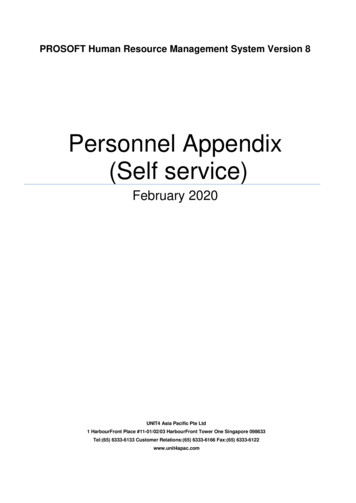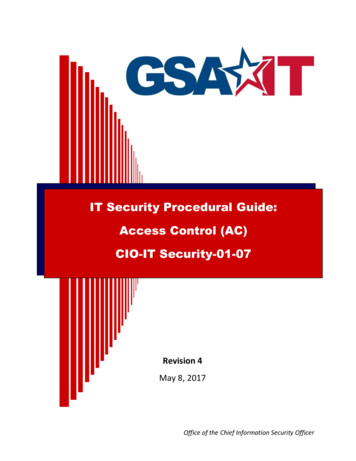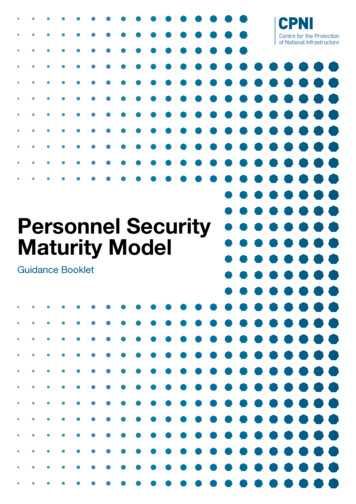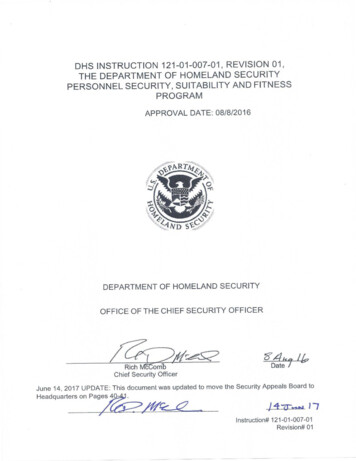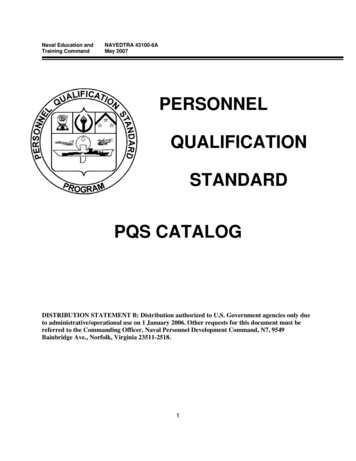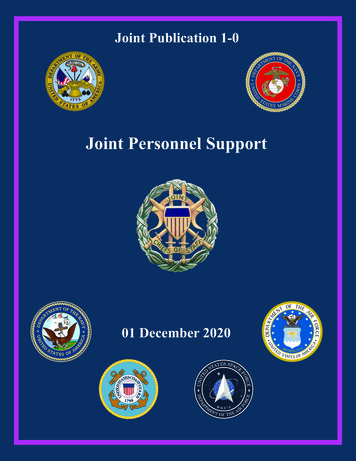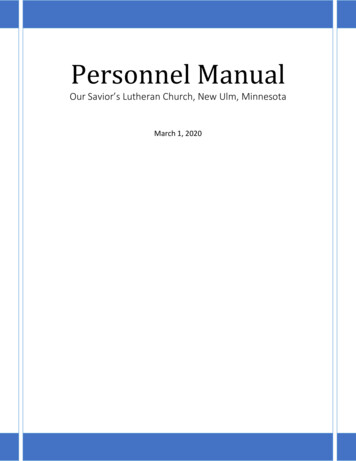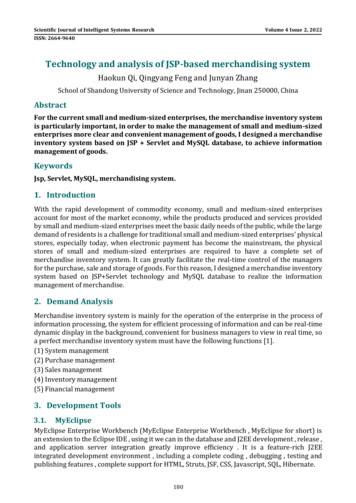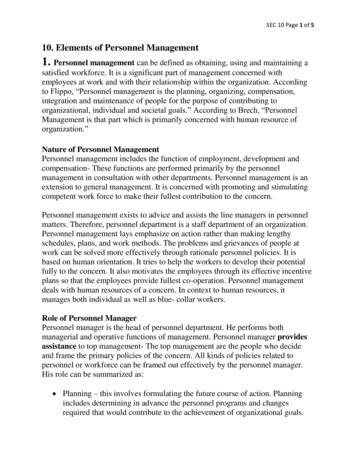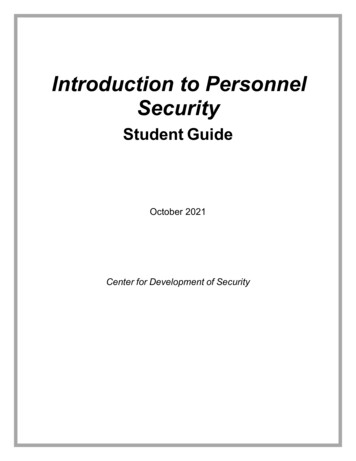
Transcription
Introduction to PersonnelSecurityStudent GuideOctober 2021Center for Development of Security
Table of ContentsCourse Introduction . 2Lesson 1: The Personnel Security Program . 3Lesson 2: Position Designation and Special Access Requirements. 13Lesson 3: Investigation and Adjudication. 19Lesson 4: Continuous Vetting and Reinvestigation . 34Lesson 5: The Security Specialist . 40Course Conclusion . 46
Introduction to Personnel SecurityStudent GuideProduct #: PS113Course IntroductionCourse IntroductionNavy personnel and shipyard coworkers were stunned to learn that one of the civilianprofessional design engineers working on the newest aircraft carrier had been arrested forespionage. Fellow employees had no idea he conspired to sell the design plans to agents of aforeign country.Their manager briefed them on the matter because this was a serious breach of national security— a true insider threat.The objective of the Personnel Security Program is to make a reasonable determination thatindividuals granted access to classified information or assigned to sensitive positions are and willremain loyal, trustworthy, and reliable.Consequently, all security specialists are tasked with understanding the Personnel SecurityProgram, or PSP. It is necessary to have a thorough understanding of its origins and processes.IntroductionWelcome to the Introduction to Personnel Security course. This training is presented with you,the student, playing the role of a new security specialist working at the Defense Security Agency,or DSA.In order to do your job better here at DSA, you will need to learn all about the DOD PersonnelSecurity Program, or PSP.Here are your course objectives.Course Objectives: Demonstrate comprehension of the personnel Security Program (PSP). Explain national security sensitive position designations and special access requirements. Apply investigative process and comprehend the national security adjudicationrequirements. Identify security specialist’s responsibilities under the PSP. Analyze the continuous evaluation and reinvestigation requirements.2
Introduction to Personnel SecurityStudent GuideProduct #: PS113Lesson 1: The Personnel Security ProgramThe Personnel Security ProgramWe will cover the definition and purpose of personnel security, Personnel Security Program(PSP) history, personnel security policies, and major components of the PSP.Lesson Objectives: Comprehend the definition and purpose of personnel security Explain the history behind the creation of the Personnel Security Program (PSP) Identify personnel security policies Identify the major components of the PSPThe Purpose of the Personnel Security ProgramWorking in the security office, you will need to explain the program to others. So, we will startby defining the purpose of the PSP.The PSP aims to protect national security by ensuring that only loyal, trustworthy, and reliableindividuals may access classified information and/or be assigned to national security sensitivepositions.The PSP establishes the standards, criteria, and guidelines upon which personnel securitydeterminations are based. The PSP uses a comprehensive background investigative process tomake this determination.The investigative process applies to members of the Armed Forces, DOD civilian employees,DOD contractors, and other affiliated people who require access to classified information or whoare assigned national security sensitive duties.The goal of the PSP is to ensure the protection of national security. Let’s talk a bit more aboutthe two key aspects of the PSP – providing access to classified information and ensuring theprotection of national security.Access to Classified InformationUnauthorized disclosure of classified or sensitive information can cause significant harm tonational security. Information that requires special protection is known as national securityinformation and may be designated as “classified.”In the U.S., there are three classified levels of information: Top Secret, Secret, and Confidential.The degree of damage to national security that could result from its unauthorized disclosuredetermines which classification applies.Top Secret is the highest level of classification. It applies to information that reasonably could be3
Introduction to Personnel SecurityStudent GuideProduct #: PS113expected to cause exceptionally grave damage to the national security if unauthorized disclosureoccurs.Secret classification applies to information that could be expected to cause serious damage to thenational security if unauthorized disclosure occurs.Confidential classification applies to information that reasonably could be expected to causedamage to the national security if unauthorized disclosure occurs.National SecurityNational security encompasses both the national defense and the foreign relations of the U.S.which must be protected from harmful individuals, organizations, and nations.One way a nation can defend itself is to maintain a good working relationship with othercountries, thereby reducing threats to our nation’s survival. Unfortunately, some national securitythreats faced by the United States come from individuals who are already inside.These are known as insider threats. Therefore, assigning individuals who possess a history ofbeing loyal, trustworthy, and reliable to sensitive positions is critical to protecting andmaintaining our national security.Character Traits of Cleared EmployeesThe United States Government expects cleared employees to be loyal, trustworthy, and reliable.But, how do we determine if individuals with a need to access national security informationpossess these traits?Three questions are asked of everyone who has a need for access to classified or sensitiveinformation. Is the individual’s allegiance solely with the United States and its basic form ofGovernment?Can the individual be trusted to properly protect classified information and/or perform othersensitive duties? Is the individual consistently willing and able to carry out securityresponsibilities?The answer to all of the above questions should be yes.The History of the PSPWe will cover the history of the PSP to better understand what it has become today. Prior to theCivil Service Act of 1883, federal employees, even at the lowest levels, were politicalappointees.The system by which people were appointed to civil service jobs was called the Spoils System.This system required allegiance to the party boss and the political party that appointed you, as4
Introduction to Personnel SecurityStudent GuideProduct #: PS113opposed to a larger sense of allegiance to the Constitution.The system by which people were appointed to civil service jobs was called the Spoils System.This system required allegiance to the party boss and the political party that appointed you, asopposed to a larger sense of allegiance to the Constitution.The employee was presumed to be loyal because in the past, he or she was loyal to the party andthe party boss. The employee won the job as a favor from the party and could only keep it bystaying in the party’s favor. This provided a powerful impetus to keep employees “party-loyal.”Because of the many abuses of the Spoils System, such as incompetent and corrupt politicalofficials, or civil servants who felt they were working for the party rather than the Americanpeople, Congress passed the Civil Service Act in 1883.The Spoils System: When Jackson was president, he fired 20% of federal officials and put in his supportersthat helped him during the election of 1828. This was known as the Spoils System.This was well known for the saying, “To the victor belong the spoils.”The meaning of the spoils system was to give appointive jobs to loyal members of theparty in power.Civil Service Act The “Magna Carta” of civil service reform1883 14,000 out of 117,000 federal government jobs became civil service exampositionsThe History of the PSP (cont.)The Civil Service Act created the U.S. Civil Service Commission. The act required employees beappointed on the basis of ability, which was demonstrated by taking an exam.This created uncertainty about the partisan allegiance of federal employees who were no longerdependent upon the party favor to keep their jobs. Their party loyalty could no longer be“bought” or necessarily even depended upon.Eventually, Congress passed the Hatch Act of 1939, which limits certain political activities ofFederal employees. It ensures administration of federal programs in a nonpartisan fashion.Moreover, the Hatch Act protects Federal employees from political coercion in the workplace. Itmakes certain that Federal employees receive advancement based on merit and not based onpolitical affiliation.5
Introduction to Personnel SecurityStudent GuideProduct #: PS113Executive Orders, Policies, Regulations, and GuidelinesThe Personnel Security Program is governed by several executive orders, or E.O.s, policies,regulations, and guidelines.Executive Orders: E.O. 10450E.O. 10450, Security Requirements for Government Employment, establishes securityrequirements for government employment. Each civilian officer or employee in any departmentor agency of the Government shall be made subject to investigation. The scope of theinvestigation shall be determined in the first instance according to the degree of adverse effectthe occupant of the position sought to be filled could bring about, by virtue of the nature of theposition, on the national securityExecutive Orders: E.O. 10865E.O. 10865, Safeguarding Classified Information within Industry, requires all persons who areemployed by the departments and agencies of the government shall be reliable, trustworthy, ofgood conduct and character, and of complete and unswerving loyalty to the United States.Executive Orders: E.O. 12968E.O. 12968, Access to Classified Information and Background Investigative Standards,establishes a uniform federal Personnel Security Program for employees who are considered forinitial or continued access to classified information.This order also establishes Security policies designed to protect classified information.Executive Orders: E.O. 13467E.O. 13467 as amended by E.O. 13764, Reforming Processes Related to Suitability forGovernment Employment, Fitness for Contractor Employees, and Eligibility for Access toClassified National Security Information.This executive order authorizes the continued evaluation of personnel who hold an activenational security eligibility determination. It designates the Director of National Intelligence asthe “Security Executive Agent” with responsibility over security and public trust clearanceprocessing, and the Office of Personnel Management as the “Suitability Executive Agent” withcontinued responsibility and authority for federal employment suitability investigations anddeterminations and authorizes continuous evaluation of personnel who hold an active nationalsecurity clearance.6
Introduction to Personnel SecurityStudent GuideProduct #: PS113Executive Orders: E.O. 13764In 2017, President Obama signed E.O. 13764, which amends the Civil Service Rules, E.O.13488, and E.O. 13467 in an effort to Modernize the Executive Branch-Wide GovernanceStructure and Processes for Security Clearances, Suitability, and Fitness for Employment, andCredentialing, and related matters.Executive Order: E.O. 13869In 2019, E.O. 13869, gave the Secretary of Defense the authority to conduct security, suitability,and credentialing background investigations for Department of Defense personnel. It alsoamended E.O. 13467 and authorized the Secretary of Defense rename the Defense SecurityService (DSS) as the Defense Counterintelligence and Security Agency (DCSA).SEADSSarah: There are five Security Executive Agency Directives or SEADs that are important ingoverning the PSP. On June 12, 2017, The Director of National Intelligence (DNI) approvedSecurity Executive Agent Directive 3 or SEAD 3, Reporting Requirements for Personnel withAccess to Classified Information or Who Hold a Sensitive Position. SEAD 3, establishesreporting requirements for all covered individuals who have access to classified information orhold a sensitive position. This Directive does not limit the authority of agency heads to imposeadditional reporting requirements in accordance with their respective authorities under law orregulation.The DNI also signed SEAD 4, National Security Adjudicative Guidelines, which establishes thesingle, common adjudicative criteria for all covered individuals who require initial or continuedeligibility for access to classified information or eligibility to hold a sensitive position. NationalSecurity Guidelines contained in SEAD 4 supersede all previously issued national securityadjudicative criteria or guidelines. Appendix B of SEAD 4 contains the language of the BondAmendment.Subsequently in January 2018, DNI also approved SEAD 6, Continuous Evaluation or CE.SEAD 6 reforms processes related to suitability for government employment, fitness forcontractor employees, and eligibility for access to classified national security information.Specifically, SEAD 6 establishes policy and requirements for the continuous evaluation ofindividuals who require continued eligibility for access to classified information or eligibility tohold a sensitive position. CE modernizes the background investigation process by maximizingautomated records checks to identify adjudicative relevant information to assist in assessing thecontinued eligibility of individuals at any time during their period of eligibility.SEAD 7 approved November 2018, Reciprocity of Background Investigations and NationalSecurity Adjudications, establishes requirements for reciprocal acceptance of backgroundinvestigation and national security adjudications for initial or continued eligibility for access toclassified information or eligibility to hold a sensitive position.7
Introduction to Personnel SecurityStudent GuideProduct #: PS113Reinforcing reciprocal requirements, SEAD 8 Temporary Eligibility, was approved in May 2020.SEAD 8 establishes policy and requirements for authorizing temporary, often referred to as“interim,” eligibility. It includes temporary access to classified information, temporary access toa higher level of classified information, one-time access to classified information, temporaryeligibility to hold a sensitive position, and temporary eligibility to hold a higher level sensitiveposition when determined to be in the national security interest.Bond AmendmentPassed in 2008, the Bond Amendment repealed Title 10 U.S.C. Section 996, formerly known asthe Smith Amendment, and placed restrictions that are similar to the Smith Amendment, butwhich apply to all Federal Government Agencies.The Bond Amendment bars persons from holding a national security eligibility for access toSpecial Access Programs, or SAPs, Restricted Data, and Sensitive Compartmented Information,or SCI, if they have been convicted of a crime and served more than one year of incarceration,were discharged from the Armed Forces under dishonorable conditions, were determined to bementally incompetent by a court or administrative agency or if they are an unlawful user of acontrolled substance or an addict.DOD RegulationsThe implementation of the Personnel Security Program or PSP within DOD is guided by DODInstruction 5200.02, DOD Personnel Security Program (PSP) and DOD Manual 5200.02,Procedures for the DOD Personnel Security Program.DODI 5200.02 establishes policies, assigns responsibilities, and prescribes procedures for theDOD Personnel Security Program, or PSP. While DOD Manual 5200.02, implements policy,assigns responsibilities, and provides procedures for the DOD PSP. This issuance assignsresponsibilities and prescribes procedures for investigations of individuals seeking to holdnational security positions or perform national security duties. The manual also sets proceduresfor DOD national security eligibility for access determinations; personnel security actions;continuous evaluation, or CE, and security education requirements for employees seekingeligibility for access to classified information or to hold a sensitive position, referred to in thismanual as "national security eligibility."Federal Investigative StandardsThe Federal Investigative Standards, also known as FIS, directed development of a five-tieredinvestigative model. This model established standard requirements for conducting nationalsecurity background investigations to determine eligibility for access to classified information, tohold a national security sensitive position, for Federal Government employment, and access toFederal Government-controlled facilities.8
Introduction to Personnel SecurityStudent GuideProduct #: PS113PSP ComponentsThe PSP uses comprehensive national security investigative and adjudicative processes andstandards when rendering eligibility determinations. Personnel Vetting or PV is the processwhich individuals undergo investigation, evaluation, and adjudication of whether they are, andremain over time, suitable or fit for Federal employment, eligible to occupy a sensitive position,eligible for access to classified information, eligible to serve as a non-appropriated fundemployee or a contractor, eligible to serve in the military, or authorized to be issued a Federalcredential.The major components to the PSP are Designation, Investigation, Adjudication, ContinuousEvaluation (Continuous Vetting), and Reinvestigation.DesignationEach position in the Federal service must be evaluated for a position sensitivity designationcommensurate with the responsibilities and assignments of the position as it relates to the impacton the national security.Such responsibilities and assignments include, but are not limited to, access to classifiedinformation that is Confidential, Secret, or Top Secret, and any other duties by which theoccupant could bring about a material adverse effect on the national security by virtue of thenature of the position.Positions designated as sensitive involve job duties that can have a great impact on nationalsecurity. Positions with job duties which have no potential for material adverse effect on nationalsecurity are designated as non-sensitive.InvestigationOnce an individual is selected for a sensitive position and/or requires access to classifiedinformation a national background investigation follows. The requisite FIS investigation dependson the position designation and risk or sensitivity level.The national background investigation obtains background information about the person that willhold a sensitive position. Once completed the information is transmitted to an adjudicativefacility for adjudication.AdjudicationAdjudication is an evaluation of the information contained in the national security backgroundinvestigations and other source documents. Analysis and evaluation of reported informationagainst the 13 National Security Adjudicative Guidelines determine an individual's nationalsecurity eligibility. National security adjudicators assigned to the DOD ConsolidatedAdjudications Facility, better known as CAF, provide the majority of national security eligibilitydeterminations.9
Introduction to Personnel SecurityStudent GuideProduct #: PS113Continuous EvaluationOnce a covered individual receives eligibility for access to classified information or holds anational security sensitive position during the period of eligibility, an ongoing process ofContinuous Vetting or CV also known as Continuous Evaluation, or CE, begins.Per E.O. 13467, as amended, CV is an ongoing personnel security investigative process utilizedto monitor and review the background of a covered individual after they have been grantedeligibility for access to classified information or to hold a national security sensitive positionduring the period of eligibility.CV leverages a set of automated records checks and business rules to assist in the ongoingassessment of an individual's continued eligibility.ReinvestigationNational security eligibility or access becomes the basis of periodic reinvestigation, which isexecuted at predetermined intervals. Individuals are periodically reinvestigated at certainintervals based on their national security eligibility or access. However, reinvestigations maybegin at any time unfavorable information emerges to raise concern under the National SecurityAdjudicative Guidelines. Reinvestigation is also a component of Continuous Vetting.Knowledge Check 1Match the term to its description.Character traits looked for in a government employeeSystem that required allegiance to a political party and not the ConstitutionEmployees appointed based on abilityProtects federal employees from political coercion in the workplaceA.B.C.D.Spoils SystemLoyal, trustworthy, reliableCivil Service ActHatch Act of 1939Answer: B, A, C, D10
Introduction to Personnel SecurityStudent GuideProduct #: PS113Knowledge Check 2Authorizes the continued evaluation of personnel who hold an active national securityeligibility determination.Establishes adjudicative criteria for covered individuals who require eligibility for accessto classified information or eligibility to hold a sensitive position.Maintains that DOD and Agency employees are reliable and trustworthy.Establishes the policy, assigns responsibilities, and prescribes procedures for the DODPersonnel Security Program.A.B.C.D.E.O. 10865Loyal, trustworthy, reliableCivil Service ActHatch Act of 1939Answer: C, D, A, BKnowledge Check 3An assessment of a position’s potential impact on the national securityA national security eligibility determination made by evaluating the information in thenational security background investigation against national standardsA part of the CV Program that happens at certain intervals based on positiondesignation or accessA report used to make a national security eligibility determinationA process that monitors employees for new information or changes that could affectan individual’s national security eligibilityA.B.C.D.E.Continuous ignationAnswer: E, C, B, D, A11
Introduction to Personnel SecurityStudent GuideProduct #: PS113Lesson SummarySarah: Great job! Looks like you’ve been reviewing the PSP as I suggested. You have learned alot and made it through your first week.This lesson covered the purpose and history of the PSP, personnel security policy, and majorcomponents of the PSP. At this point, you should have an understanding of how the PersonnelSecurity Program has evolved and why it is so important. Remember, the PSP seeks to ensureonly loyal, trustworthy, and reliable individuals receive eligibility to access classifiedinformation or assignment to national security sensitive duties.The bottom line is to protect national security by employing those individuals who meet thestandards, criteria, and guidelines of the Personnel Security Program.12
Introduction to Personnel SecurityStudent GuideProduct #: PS113Lesson 2: Position Designation and Special Access RequirementsLesson IntroductionThis week we begin concentrating on position designation and special access requirements.Our goal for the week is to cover national security sensitive position designations, requirementsfor access to classified information including assignment to sensitive positions, and specialaccess requirements.Lesson Objectives: Comprehend national security sensitive position designations Identify the requirements to access classified information including assignment to asensitive position Recognize the different special access requirementsAccessAs security specialists, you may hear people talk about their clearances. But these days we talk interms of national security eligibility and the level of access that corresponds to their positiondesignation.Designated positions correlate to the potentially adverse impact on national security.Access is the ability and opportunity to gain knowledge of classified information. This involvesseeing, hearing, or touching classified information, material, or equipment.The holder of information always controls access to the information or material. Therefore, theholder of the classified national security information has the responsibility to determine if theperson seeking access has appropriate national security eligibility, access, and a validneed-to-know for the information in order to carry out their official duties.To obtain a national security eligibility, you have to obtain a favorable determination.Component and local organization procedures provide guidance on how to verify nationalsecurity eligibility and need-to-know.Types of AccessNot just anyone can access classified information. There are two basic types of authorizations forgranting access depending on whether you are a U.S. citizen or a non-U.S. citizen. If anindividual is a U.S. citizen, that individual may receive national security eligibility.If an individual is not a U.S. citizen, that individual may receive a Limited Access Authorization,also known as an LAA. These two authorizations may be granted to civilian, military, andcontractor personnel; however, their requirements for access will vary.13
Introduction to Personnel SecurityStudent GuideProduct #: PS113It is important to understand that although a non-U.S. citizen may receive an LAA, a non-U.S.citizen is not granted national security eligibility.Designation CategoriesCivilian personnel designation requirements vary based on how the position is categorized. OPMdefines the four civilian position sensitivity levels as special-sensitive, critical-sensitive,noncritical-sensitive, and non-sensitive.When there is a mix of duties, the highest level of duty determines the sensitivity. Thedesignation of sensitive positions meets the stated criteria for a specific security designation andis necessary to meet mission requirements.Special-SensitiveSpecial-sensitive national security positions are civilian national security positions that maypotentially cause inestimable damage to the national security or adverse impact to the efficiencyof the DOD or military services. This includes positions requiring eligibility for access tosensitive compartmented information or SCI, positions requiring eligibility for access to uniqueor uniquely productive intelligence-related special-sensitive information or involvement withspecial access programs, or SAPs, any civilian position the DOD Component head determines tobe a higher level than critical-sensitive due to its special requirements.Critical-SensitiveCritical-sensitive positions are civilian national security positions that have the potential to causeexceptionally grave damage to the nation’s security, including but not limited to, positionsrequiring eligibility for access to Top Secret or DOE “Q” level classified information, positionsinvolving development or approval of war plans, major or special operations of war, or criticaland extremely important items of war, national security policy-making or policy-determiningpositions, the duties of which have the potential to cause exceptionally grave damage to thenational security, positions involving investigative duties, including handling of CI investigationsor background investigations, the nature of which has the potential to cause exceptionally gravedamage to the national security.Fiduciary duties: Duties that involve the obligation, expenditure, collection, or control ofrevenue, funds, or items with value over 50 million dollars, or procurement or securing fundingfor goods or services with monetary value in excess of 50 million dollars annually.Examples of Critical-Sensitive Duties: Eligibility for access to Top Secret or Department of Energy Q-level classifiedinformationDevelopment or approval of war plans, war operations, or critical and extremelyimportant items of warNational security policy making or determining duties having potential to cause14
Introduction to Personnel SecurityStudent Guide Product #: PS113exceptionally grave damageInvestigative duties involving counterintelligence or background investigations that havethe potential to cause exceptionally grave damage to the national securityDuties related to adjudication, adjudicative determination recommendations, or grantingof national security eligibilityDuties on personnel security boardsDuties involving development or approval of plans, policies, or programs that impactDOD operationsDuties involving the conduct of CI activitiesSenior management positions in key programs that could result in exceptionally gravedamage if compromisedPositions having direct involvement with diplomatic relations/negotiationsPositions involving independent responsibility for planning or approving continuity ofgovernment operationsPositions in which the occupant has the ability to independently damage public healthand safety with devastating resultsPositions in which the occupant has the ability to independently compromise or exploitbiological select agents or toxins, chemical agents, nuclear materials, or other hazardousmaterialsPositions in which the occupant has the ability to independently compromise or exploitthe nation’s nuclear or chemical weapons designs or systemsPositions in which the occupant has direct, unrestricted cont
In 2019, E.O. 13869, gave the Secretary of Defense the authority to conduct security, suitability, and credentialing background investigations for Department of Defense personnel. It also amended E.O. 13467 and authorized the Secretary of Defense rename the Defense Security Service (DSS) as the Defense Counterintelligence and Security Agency .
